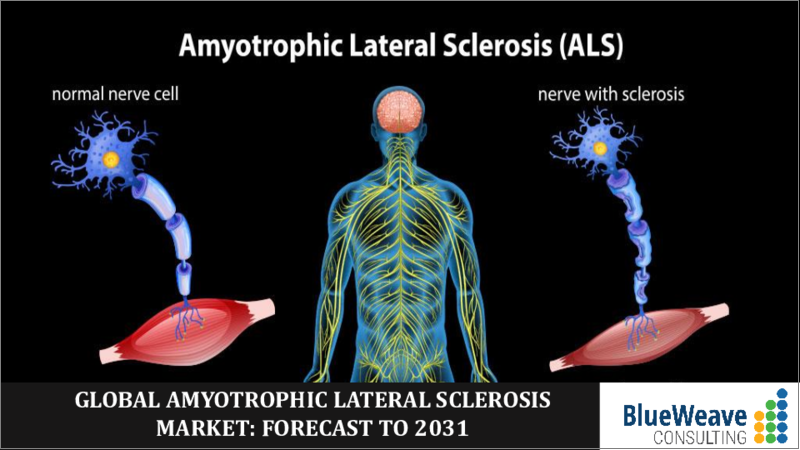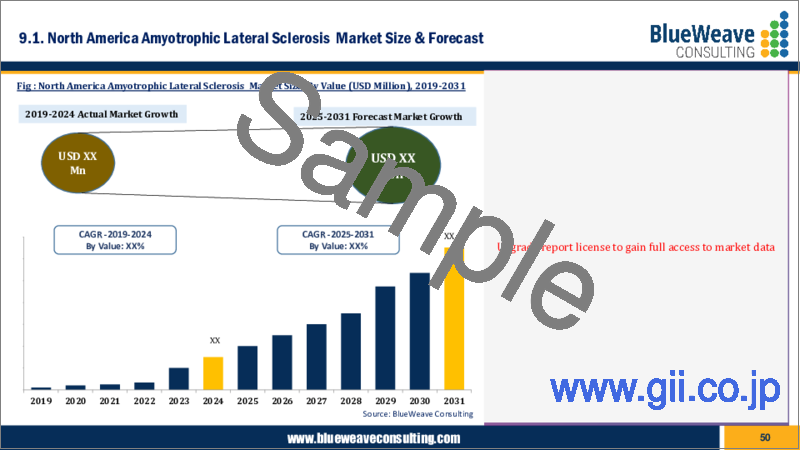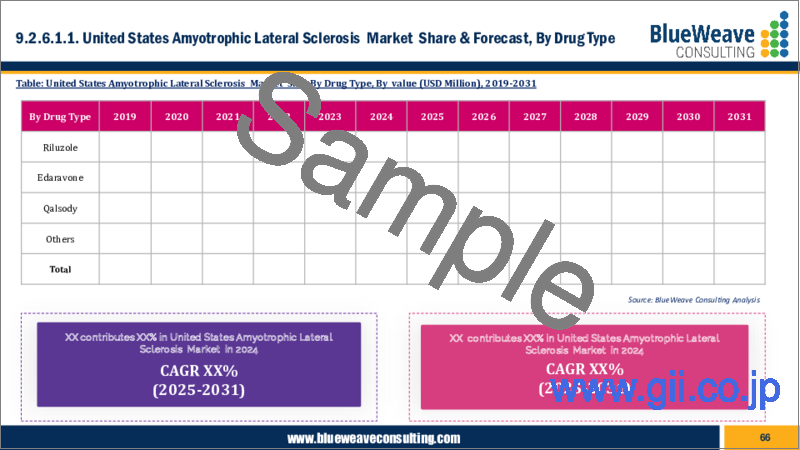|
|
市場調査レポート
商品コード
1539203
筋萎縮性側索硬化症(ALS)市場:世界の規模、シェア、動向分析、機会、予測、2019-2030年Amyotrophic Lateral Sclerosis Market - Global Size, Share, Trend Analysis, Opportunity and Forecast, 2019-2030, Segmented By Type; By Treatment; By End User; By Region |
||||||
|
|||||||
| 筋萎縮性側索硬化症(ALS)市場:世界の規模、シェア、動向分析、機会、予測、2019-2030年 |
|
出版日: 2024年08月01日
発行: Blueweave Consulting
ページ情報: 英文 400 Pages
納期: 2~3営業日
|
全表示
- 概要
- 目次
筋萎縮性側索硬化症(ALS)の世界市場規模は大幅なCAGRで拡大し、2030年には14億5,000万米ドルを突破へ
筋萎縮性側索硬化症(ALS)の世界市場は、ALSの有病率の上昇、認知度の向上、治療法の選択肢の進歩、より効果的な治療法の研究開発努力の強化に向けた政府からの資金提供などにより、活況を呈しています。
戦略コンサルティングと市場調査の大手企業であるBlueWeave Consulting社は、最近の調査で、2023年の筋萎縮性側索硬化症(ALS)の世界市場規模を金額ベースで9億200万米ドルと推定しました。2024年から2030年にかけての予測期間において、筋萎縮性側索硬化症(ALS)の世界市場規模はCAGR 7.10%で拡大し、2030年には14億5,600万米ドルに達するとBlueWeaveは予測しています。筋萎縮性側索硬化症(ALS)の世界市場は、罹患率の増加、医学研究の進歩、ALSに関する認知度の向上が原動力となっています。診断技術の向上やALS治療のためのバイオテクノロジーへの投資の増加が大きく貢献しています。さらに、各国政府による希少疾病研究への支援やイニシアチブ、製薬企業と研究機関の協力関係も市場の成長を後押ししています。新規治療法の開発やALS治療のための臨床試験の増加は、筋萎縮性側索硬化症(ALS)の世界市場の成長をさらに後押ししています。
機会- 新規治療法の研究開発イニシアティブ
筋萎縮性側索硬化症(ALS)の世界市場の成長は、新規治療法の発見を目的とした研究開発イニシアチブの増加によって大きく牽引されています。製薬会社や研究機関は、遺伝子治療、幹細胞治療、新薬候補などの革新的な治療を開発するため、研究開発に多額の投資を行っています。こうした治療法の進歩は患者の予後を改善し、より効果的な治療選択肢を提供することで市場の成長を促し、ALSの管理改善に希望をもたらすと期待されています。
地政学的緊張の高まりが筋萎縮性側索硬化症(ALS)世界市場に与える影響
地政学的緊張の高まりは、筋萎縮性側索硬化症(ALS)の世界市場に大きな影響を与える可能性があります。国際貿易やサプライチェーンの混乱はALS治療薬の生産や流通の遅れにつながる可能性があります。規制当局の監視や貿易規制の強化は、必要不可欠な医薬品や医療機器の入手に影響を与える可能性があります。さらに、ALS研究のための資金が目先の地政学的懸念に対応するために流用され、治療法の進歩が遅れる可能性もあります。為替レートの変動や経済の不安定は、ヘルスケア提供者や患者のコストを増加させる可能性があります。全体として、地政学的不安定は効果的なALS治療へのアクセスや市場開発を妨げ、患者の治療や市場の成長に影響を与える可能性があります。
ALS治療薬の主要エンドユーザーは専門病院である
筋萎縮性側索硬化症(ALS)の世界市場は、専門施設と研究・学術機関をエンドユーザーとしています。筋萎縮性側索硬化症(ALS)世界市場のエンドユーザー別成長では、専門医療機関が大きく貢献しています。ALS患者に特化した専門的な治療や高度な治療オプションが提供されているためです。これらの施設は、診断、集学的治療、臨床試験へのアクセスなど包括的なサービスを提供しているため、患者にとって好ましい選択肢となっており、市場での優位性を高めています。
競合情勢
筋萎縮性側索硬化症(ALS)の世界市場は熾烈な競争を繰り広げており、数多くの企業がより大きな市場シェアを争っています。市場の主要企業には、田辺三菱製薬、大塚製薬、BrainStorm Therapeutics、Biogen Inc.、Corestem、AB Science、F. Hoffmann-La Roche AG、Biohaven Pharmaceutical、Sun Pharmaceutical、Ionis Pharmaceuticals, Inc.などがあります。これらの企業は、世界の筋萎縮性側索硬化症(ALS)市場における地位をさらに強化するために、研究開発活動への投資拡大、M&A、合弁事業、提携、ライセンス契約、新製品・サービスのリリースなど、様々な戦略を駆使しています。
本レポートの詳細な分析により、世界の筋萎縮性側索硬化症(ALS)市場の成長可能性、今後の動向、統計に関する情報を提供します。また、総市場規模の予測を促進する要因にも焦点を当てます。本レポートは、世界の筋萎縮性側索硬化症(ALS)市場における最近の技術動向や、意思決定者が健全な戦略的意思決定を行うための業界洞察を提供することを約束します。さらに、市場の成長促進要因・課題・競争力についても分析しています。
目次
第1章 調査の枠組み
第2章 エグゼクティブサマリー
第3章 世界の筋萎縮性側索硬化症(ALS)市場の洞察
- 業界バリューチェーン分析
- DROC分析
- 成長促進要因
- 世界中でALSの罹患率が増加
- ALS治療のための医学調査と技術の進歩
- ヘルスケア費支出と医療意識の高まり
- 神経疾患にかかりやすい高齢者人口の増加
- 抑制要因
- ALS治療オプションの高コスト
- 現在の治療法の有効性は限られている
- 医薬品の承認に関する厳格な規制要件
- 機会
- 新しい治療法の研究開発の取り組み
- 製薬企業と調査機関の連携
- 早期発見のための診断ツールの技術的進歩
- 課題
- 実験的なALS治療に関する倫理的懸念
- 地域によってALS治療へのアクセスが不平等
- 成長促進要因
- 技術の進歩/最近の動向
- 規制の枠組み
- ポーターのファイブフォース分析
第4章 世界の筋萎縮性側索硬化症(ALS)市場:マーケティング戦略
第5章 世界の筋萎縮性側索硬化症(ALS)市場:価格分析
第6章 世界の筋萎縮性側索硬化症(ALS)市場:地域分析
第7章 世界の筋萎縮性側索硬化症(ALS)市場概要
- 市場規模と予測、2019-2030年
- 金額別
- 市場シェアと予測
- タイプ別
- 散発性ALS(SALS)
- 家族性ALS(FALS)
- 治療別
- 薬
- 理学療法
- 呼吸療法
- 言語療法
- その他
- エンドユーザー別
- 専門センター
- 調査・学術機関
- その他
- 地域別
- 北米
- 欧州
- アジア太平洋地域(APAC)
- ラテンアメリカ(LATAM)
- 中東およびアフリカ(中東・アフリカ)
- タイプ別
第8章 北米の筋萎縮性側索硬化症(ALS)市場
- 市場規模と予測、2019-2030年
- 金額別
- 市場シェアと予測
- タイプ別
- 治療別
- エンドユーザー別
- 国別
- 米国
- カナダ
第9章 欧州の筋萎縮性側索硬化症(ALS)市場
- 市場規模と予測、2019-2030年
- 金額別
- 市場シェアと予測
- タイプ別
- 治療別
- エンドユーザー別
- 国別
- ドイツ
- 英国
- イタリア
- フランス
- スペイン
- ベルギー
- ロシア
- オランダ
- その他欧州
第10章 アジア太平洋地域の筋萎縮性側索硬化症(ALS)市場
- 市場規模と予測、2019-2030年
- 金額別
- 市場シェアと予測
- タイプ別
- 治療別
- エンドユーザー別
- 国別
- 中国
- インド
- 日本
- 韓国
- オーストラリアとニュージーランド
- インドネシア
- マレーシア
- シンガポール
- ベトナム
- アジア太平洋地域のその他諸国
第11章 ラテンアメリカの筋萎縮性側索硬化症(ALS)市場
- 市場規模と予測、2019-2030年
- 金額別
- 市場シェアと予測
- タイプ別
- 治療別
- エンドユーザー別
- 国別
- ブラジル
- メキシコ
- アルゼンチン
- ペルー
- その他のラテンアメリカ
第12章 中東およびアフリカの筋萎縮性側索硬化症(ALS)市場
- 市場規模と予測、2019-2030年
- 金額別
- 市場シェアと予測
- タイプ別
- 治療別
- エンドユーザー別
- 国別
- サウジアラビア
- アラブ首長国連邦
- カタール
- クウェート
- 南アフリカ
- ナイジェリア
- アルジェリア
- 中東・アフリカの残り
第13章 競合情勢
- 主要企業とその提供内容のリスト
- 2023年の世界筋萎縮性側索硬化症(ALS)市場シェア分析
- 経営パラメータによる競合ベンチマーキング
- 主要な戦略的展開(合併、買収、提携など)
第14章 高まる地政学的緊張が世界の筋萎縮性側索硬化症(ALS)市場に与える影響
第15章 企業プロファイル(会社概要、財務マトリックス、競合情勢、主要人物、主要競合、連絡先、戦略展望、 SWOT分析)
- Mitsubishi Tanabe Pharma Corporation
- Otsuka Pharmaceutical Co., Ltd
- BrainStorm Therapeutics
- Biogen Inc.
- Corestem
- AB Science
- F.Hoffmann-La Roche AG
- Biohaven Pharmaceutical
- Sun Pharmaceutical
- Ionis Pharmaceuticals, Inc.
- その他の主要企業
第16章 主要な戦略的提言
第17章 調査手法
Global Amayotrophic Lateral Sclerosis (ALS) Market Size to Expand at Significant CAGR to Surpass USD 1.45 Billion by 2030
Global Amayotrophic Lateral Sclerosis (ALS) Market is thriving due to rising ALS prevalence, increased awareness, advancements in therapeutic options, and government funding in enhancing research and development efforts for more effective treatments.
BlueWeave Consulting, a leading strategic consulting, and Market research firm, in its recent study, estimated Global Amayotrophic Lateral Sclerosis (ALS) Market size by value at USD 902 million in 2023. During the forecast period between 2024 and 2030, BlueWeave expects Global Amayotrophic Lateral Sclerosis (ALS) Market size to expand at a CAGR of 7.10% reaching a value of USD 1,456 million in 2030. Global Amyotrophic Lateral Sclerosis (ALS) Market is driven by increasing incidence rates, advancements in medical research, and rising awareness about ALS. Enhanced diagnostic techniques and growing investment in biotechnology for ALS treatment contribute significantly. Additionally, governments' support and initiatives for rare disease research, along with collaborations between pharmaceutical companies and research institutions, propel market growth. The development of novel therapies and increasing clinical trials for ALS treatments further boost the growth of Global Amayotrophic Lateral Sclerosis (ALS) Market.
Opportunity - R&D initiatives for novel therapies
The growth of Global Amyotrophic Lateral Sclerosis (ALS) Market is significantly driven by increased research and development initiatives aimed at discovering novel therapies. Pharmaceutical companies and research institutions are investing heavily in R&D to develop innovative treatments, such as gene therapies, stem cell therapies, and novel drug candidates. These advancements are expected to improve patient outcomes and provide more effective treatment options, fueling market growth and offering hope for better management of ALS.
Impact of Escalating Geopolitical Tensions on Global Amayotrophic Lateral Sclerosis (ALS) Market
Escalating geopolitical tensions can significantly impact the Global Amyotrophic Lateral Sclerosis (ALS) Market. Disruptions in international trade and supply chains may lead to delays in the production and distribution of ALS medications and therapies. Increased regulatory scrutiny and trade restrictions can affect the availability of essential drugs and medical devices. Additionally, funding for ALS research may be diverted to address immediate geopolitical concerns, slowing advancements in treatment options. Fluctuations in currency exchange rates and economic instability can increase costs for healthcare providers and patients. Overall, geopolitical instability can hinder the accessibility and development of effective ALS treatments, impacting patient care and market growth.
Specialty Centers Are Major End Users of ALS Therapies
Global Amyotrophic Lateral Sclerosis (ALS) Market is comprised of specialty centers and research & academic institutes as end users. The specialty centers segment is a higher contributor to the growth of Global Amyotrophic Lateral Sclerosis (ALS) Market by end user. The segment dominates due to the specialized care and advanced treatment options provided by these centers, which cater specifically to ALS patients. These facilities offer comprehensive services, including diagnostics, multidisciplinary care, and access to clinical trials, making them the preferred choice for patients and driving their prominence in the market.
Competitive Landscape
Global Amayotrophic Lateral Sclerosis (ALS) Market is fiercely competitive, with numerous companies vying for a larger market share. Major companies in the market include Mitsubishi Tanabe Pharma Corporation, Otsuka Pharmaceutical Co., Ltd, BrainStorm Therapeutics, Biogen Inc., Corestem, AB Science, F. Hoffmann-La Roche AG, Biohaven Pharmaceutical, Sun Pharmaceutical, and Ionis Pharmaceuticals, Inc. These companies use various strategies, including increasing investments in their R&D activities, mergers and acquisitions, joint ventures, collaborations, licensing agreements, and new product and service releases to further strengthen their position in Global Amayotrophic Lateral Sclerosis (ALS) Market.
The in-depth analysis of the report provides information about growth potential, upcoming trends, and statistics of Global Amayotrophic Lateral Sclerosis (ALS) Market. It also highlights the factors driving forecasts of total Market size. The report promises to provide recent technology trends in Global Amayotrophic Lateral Sclerosis (ALS) Market and industry insights to help decision-makers make sound strategic decisions. Further, the report also analyzes the growth drivers, challenges, and competitive dynamics of the market.
Table of Contents
1. Research Framework
- 1.1. Research Objective
- 1.2. Product Overview
- 1.3. Market Segmentation
2. Executive Summary
3. Global Amyotrophic Lateral Sclerosis (ALS) Market Insights
- 3.1. Industry Value Chain Analysis
- 3.2. DROC Analysis
- 3.2.1. Growth Drivers
- 3.2.1.1. Increasing prevalence of ALS globally
- 3.2.1.2. Advances in medical research and technology for ALS treatment
- 3.2.1.3. Growing healthcare expenditure and awareness
- 3.2.1.4. Rising geriatric population susceptible to neurological disorders
- 3.2.2. Restraints
- 3.2.2.1. High cost of ALS treatment options
- 3.2.2.2. Limited effectiveness of current therapies
- 3.2.2.3. Stringent regulatory requirements for drug approval
- 3.2.3. Opportunities
- 3.2.3.1. Research and development initiatives for novel therapies
- 3.2.3.2. Collaborations between pharmaceutical companies and research institutions
- 3.2.3.3. Technological advancements in diagnostic tools for early detection
- 3.2.4. Challenges
- 3.2.4.1. Ethical concerns related to experimental ALS therapies
- 3.2.4.2. Uneven access to ALS treatments across different regions
- 3.2.1. Growth Drivers
- 3.3. Technological Advancements/Recent Developments
- 3.4. Regulatory Framework
- 3.5. Porter's Five Forces Analysis
- 3.5.1. Bargaining Power of Suppliers
- 3.5.2. Bargaining Power of Buyers
- 3.5.3. Threat of New Entrants
- 3.5.4. Threat of Substitutes
- 3.5.5. Intensity of Rivalry
4. Global Amyotrophic Lateral Sclerosis (ALS) Market: Marketing Strategies
5. Global Amyotrophic Lateral Sclerosis (ALS) Market: Pricing Analysis
6. Global Amyotrophic Lateral Sclerosis (ALS) Market: Geographical Analysis
7. Global Amyotrophic Lateral Sclerosis (ALS) Market Overview
- 7.1. Market Size & Forecast, 2019-2030
- 7.1.1. By Value (USD Billion)
- 7.2. Market Share and Forecast
- 7.2.1. By Type
- 7.2.1.1. Sporadic ALS (SALS)
- 7.2.1.2. Familial ALS (FALS)
- 7.2.2. By Treatment
- 7.2.2.1. Medication
- 7.2.2.2. Physical Therapy
- 7.2.2.3. Respiratory Therapy
- 7.2.2.4. Speech Therapy
- 7.2.2.5. Others
- 7.2.3. By End User
- 7.2.3.1. Specialty Centers
- 7.2.3.2. Research & Academic Institutes
- 7.2.3.3. Others
- 7.2.4. By Region
- 7.2.4.1. North America
- 7.2.4.2. Europe
- 7.2.4.3. Asia Pacific (APAC)
- 7.2.4.4. Latin America (LATAM)
- 7.2.4.5. Middle East and Africa (MEA)
- 7.2.1. By Type
8. North America Amyotrophic Lateral Sclerosis (ALS) Market
- 8.1. Market Size & Forecast, 2019-2030
- 8.1.1. By Value (USD Billion)
- 8.2. Market Share & Forecast
- 8.2.1. By Type
- 8.2.2. By Treatment
- 8.2.3. By End User
- 8.2.4. By Country
- 8.2.4.1. United States
- 8.2.4.1.1. By Type
- 8.2.4.1.2. By Treatment
- 8.2.4.1.3. By End User
- 8.2.4.2. Canada
- 8.2.4.2.1. By Type
- 8.2.4.2.2. By Treatment
- 8.2.4.2.3. By End User
9. Europe Amyotrophic Lateral Sclerosis (ALS) Market
- 9.1. Market Size & Forecast, 2019-2030
- 9.1.1. By Value (USD Billion)
- 9.2. Market Share & Forecast
- 9.2.1. By Type
- 9.2.2. By Treatment
- 9.2.3. By End User
- 9.2.4. By Country
- 9.2.4.1. Germany
- 9.2.4.1.1. By Type
- 9.2.4.1.2. By Treatment
- 9.2.4.1.3. By End User
- 9.2.4.2. United Kingdom
- 9.2.4.2.1. By Type
- 9.2.4.2.2. By Treatment
- 9.2.4.2.3. By End User
- 9.2.4.3. Italy
- 9.2.4.3.1. By Type
- 9.2.4.3.2. By Treatment
- 9.2.4.3.3. By End User
- 9.2.4.4. France
- 9.2.4.4.1. By Type
- 9.2.4.4.2. By Treatment
- 9.2.4.4.3. By End User
- 9.2.4.5. Spain
- 9.2.4.5.1. By Type
- 9.2.4.5.2. By Treatment
- 9.2.4.5.3. By End User
- 9.2.4.6. Belgium
- 9.2.4.6.1. By Type
- 9.2.4.6.2. By Treatment
- 9.2.4.6.3. By End User
- 9.2.4.7. Russia
- 9.2.4.7.1. By Type
- 9.2.4.7.2. By Treatment
- 9.2.4.7.3. By End User
- 9.2.4.8. The Netherlands
- 9.2.4.8.1. By Type
- 9.2.4.8.2. By Treatment
- 9.2.4.8.3. By End User
- 9.2.4.9. Rest of Europe
- 9.2.4.9.1. By Type
- 9.2.4.9.2. By Treatment
- 9.2.4.9.3. By End User
10. Asia Pacific Amyotrophic Lateral Sclerosis (ALS) Market
- 10.1. Market Size & Forecast, 2019-2030
- 10.1.1. By Value (USD Billion)
- 10.2. Market Share & Forecast
- 10.2.1. By Type
- 10.2.2. By Treatment
- 10.2.3. By End User
- 10.2.4. By Country
- 10.2.4.1. China
- 10.2.4.1.1. By Type
- 10.2.4.1.2. By Treatment
- 10.2.4.1.3. By End User
- 10.2.4.2. India
- 10.2.4.2.1. By Type
- 10.2.4.2.2. By Treatment
- 10.2.4.2.3. By End User
- 10.2.4.3. Japan
- 10.2.4.3.1. By Type
- 10.2.4.3.2. By Treatment
- 10.2.4.3.3. By End User
- 10.2.4.4. South Korea
- 10.2.4.4.1. By Type
- 10.2.4.4.2. By Treatment
- 10.2.4.4.3. By End User
- 10.2.4.5. Australia & New Zealand
- 10.2.4.5.1. By Type
- 10.2.4.5.2. By Treatment
- 10.2.4.5.3. By End User
- 10.2.4.6. Indonesia
- 10.2.4.6.1. By Type
- 10.2.4.6.2. By Treatment
- 10.2.4.6.3. By End User
- 10.2.4.7. Malaysia
- 10.2.4.7.1. By Type
- 10.2.4.7.2. By Treatment
- 10.2.4.7.3. By End User
- 10.2.4.8. Singapore
- 10.2.4.8.1. By Type
- 10.2.4.8.2. By Treatment
- 10.2.4.8.3. By End User
- 10.2.4.9. Vietnam
- 10.2.4.9.1. By Type
- 10.2.4.9.2. By Treatment
- 10.2.4.9.3. By End User
- 10.2.4.10. Rest of APAC
- 10.2.4.10.1. By Type
- 10.2.4.10.2. By Treatment
- 10.2.4.10.3. By End User
11. Latin America Amyotrophic Lateral Sclerosis (ALS) Market
- 11.1. Market Size & Forecast, 2019-2030
- 11.1.1. By Value (USD Billion)
- 11.2. Market Share & Forecast
- 11.2.1. By Type
- 11.2.2. By Treatment
- 11.2.3. By End User
- 11.2.4. By Country
- 11.2.4.1. Brazil
- 11.2.4.1.1. By Type
- 11.2.4.1.2. By Treatment
- 11.2.4.1.3. By End User
- 11.2.4.2. Mexico
- 11.2.4.2.1. By Type
- 11.2.4.2.2. By Treatment
- 11.2.4.2.3. By End User
- 11.2.4.3. Argentina
- 11.2.4.3.1. By Type
- 11.2.4.3.2. By Treatment
- 11.2.4.3.3. By End User
- 11.2.4.4. Peru
- 11.2.4.4.1. By Type
- 11.2.4.4.2. By Treatment
- 11.2.4.4.3. By End User
- 11.2.4.5. Rest of LATAM
- 11.2.4.5.1. By Type
- 11.2.4.5.2. By Treatment
- 11.2.4.5.3. By End User
12. Middle East & Africa Amyotrophic Lateral Sclerosis (ALS) Market
- 12.1. Market Size & Forecast, 2019-2030
- 12.1.1. By Value (USD Billion)
- 12.2. Market Share & Forecast
- 12.2.1. By Type
- 12.2.2. By Treatment
- 12.2.3. By End User
- 12.2.4. By Country
- 12.2.4.1. Saudi Arabia
- 12.2.4.1.1. By Type
- 12.2.4.1.2. By Treatment
- 12.2.4.1.3. By End User
- 12.2.4.2. UAE
- 12.2.4.2.1. By Type
- 12.2.4.2.2. By Treatment
- 12.2.4.2.3. By End User
- 12.2.4.3. Qatar
- 12.2.4.3.1. By Type
- 12.2.4.3.2. By Treatment
- 12.2.4.3.3. By End User
- 12.2.4.4. Kuwait
- 12.2.4.4.1. By Type
- 12.2.4.4.2. By Treatment
- 12.2.4.4.3. By End User
- 12.2.4.5. South Africa
- 12.2.4.5.1. By Type
- 12.2.4.5.2. By Treatment
- 12.2.4.5.3. By End User
- 12.2.4.6. Nigeria
- 12.2.4.6.1. By Type
- 12.2.4.6.2. By Treatment
- 12.2.4.6.3. By End User
- 12.2.4.7. Algeria
- 12.2.4.7.1. By Type
- 12.2.4.7.2. By Treatment
- 12.2.4.7.3. By End User
- 12.2.4.8. Rest of MEA
- 12.2.4.8.1. By Type
- 12.2.4.8.2. By Treatment
- 12.2.4.8.3. By End User
13. Competitive Landscape
- 13.1. List of Key Players and Their Offerings
- 13.2. Global Amyotrophic Lateral Sclerosis (ALS) Market Share Analysis, 2023
- 13.3. Competitive Benchmarking, By Operating Parameters
- 13.4. Key Strategic Developments (Mergers, Acquisitions, Partnerships, etc.)
14. Impact of Escalating Geopolitical Tensions on Global Amyotrophic Lateral Sclerosis (ALS) Market
15. Company Profiles (Company Overview, Financial Matrix, Competitive Landscape, Key Personnel, Key Competitors, Contact Address, Strategic Outlook, and SWOT Analysis)
- 15.1. Mitsubishi Tanabe Pharma Corporation
- 15.2. Otsuka Pharmaceutical Co., Ltd
- 15.3. BrainStorm Therapeutics
- 15.4. Biogen Inc.
- 15.5. Corestem
- 15.6. AB Science
- 15.7. F.Hoffmann-La Roche AG
- 15.8. Biohaven Pharmaceutical
- 15.9. Sun Pharmaceutical
- 15.10. Ionis Pharmaceuticals, Inc.
- 15.11. Other Prominent Players
16. Key Strategic Recommendations
17. Research Methodology
- 17.1. Qualitative Research
- 17.1.1. Primary & Secondary Research
- 17.2. Quantitative Research
- 17.3. Market Breakdown & Data Triangulation
- 17.3.1. Secondary Research
- 17.3.2. Primary Research
- 17.4. Breakdown of Primary Research Respondents, By Region
- 17.5. Assumptions & Limitations
*Financial information of non-listed companies can be provided as per availability.
**The segmentation and the companies are subject to modifications based on in-depth secondary research for the final deliverable






